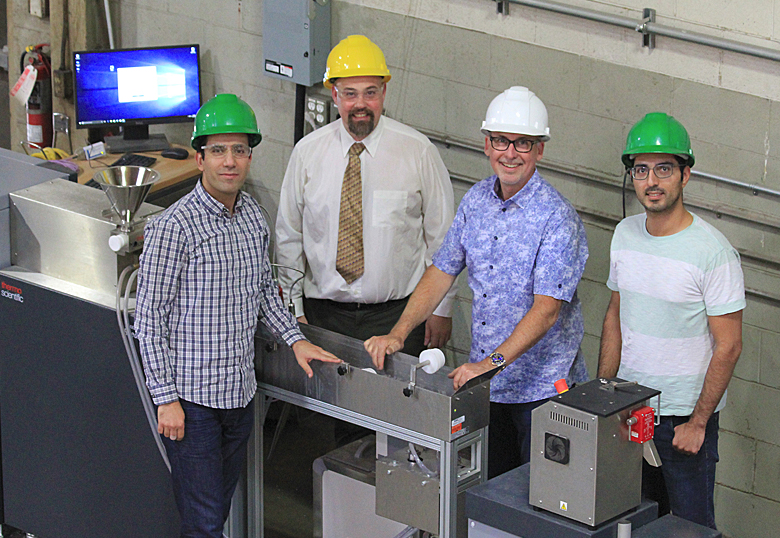The University of Lethbridge, in collaboration with Western Economic Diversification Canada (WD) and Flexahopper Plastics, is taking a leading role in combatting environmental pollution through the establishment of a Green Polymer and Technology Centre.
The centre’s goal of developing biodegradable plastics that don’t use fossil fuel feedstocks or require fossil fuels to process is still years away, but the research can begin now thanks to a $1-million investment from WD.

“The Government of Canada recognizes green technology as a way to create good middle-class jobs for Canadians while also meeting climate change objectives,” says The Honourable Navdeep Bains, Minister of Innovation, Science and Economic Development and Minister responsible for Western Economic Diversification Canada. “With our investment, the University of Lethbridge will develop a green polymer and technology centre to reduce plastic waste and reliance on fossil fuels. Thoughtful and strategic investments like this drive innovation, make Canada a world leader in research development, and protect our environment. Today we are one step closer to our vision of a more sustainable, greener future to ensure Canadians have healthy, productive places to live, access to jobs, and expanded business growth opportunities.”
Dr. Paul Hazendonk, a U of L professor in the Department of Chemistry & Biochemistry with expertise in polymer chemistry, says the collaborative approach is designed to meet industry need.
“I do understand the issues that businesses have to deal with,” says Dr. Paul Hazendonk, a U of L professor in the Department of Chemistry & Biochemistry with expertise in polymer chemistry. “We hope to find ways for businesses to go greener without them being exposed too much to the up-front development costs. We have a good suite of instrumentation now, thanks to WD, and we have the expertise.”
“I’m really excited for Lethbridge and the University because this collaborative work will hopefully seed the growth of other projects with industry and help attract more companies to the region,” says Bill Spenceley (BASc ’81), president of Flexahopper, an international plastics processor headquartered in Lethbridge serving aerospace, oil and gas, agricultural and food-processing markets.
The investment is part of the U of L’s SHINE campaign announced last Thursday and this partnership highlights the importance of the U of L’s connection to the community, specifically how expertise available at the University helps solve problems at the local level and beyond and leads to opportunities for economic growth and a more sustainable future.
The polymer industry is built on the use of polyethylene, which is made from fossil fuel feedstocks and natural gas byproducts. The processing of polyethylene requires heat, also sourced from fossil fuels. Polyethylene has unique properties that make it extremely well suited to a vast array of processing techniques for making plastic products. Unfortunately, plastic pollution is becoming an increasingly serious problem affecting wildlife, wildlife habitat and humans.
“We have a whole line of plastics out there that can be sourced from feedstocks from agriculture,” says Hazendonk. “For instance, cornstarch is used to make polylactic acid (PLA) and it’s biodegradable. The problem is that you can’t just substitute one polymer for another when it comes to processing. There are a lot of hurdles to overcome and we probably are in for decades of development before we can even come close to making viable green plastics.”
The first step in creating green-based plastics is to make composite materials. Designing the appropriate additives requires researchers to gain insight into their molecular structure and phase behaviour using a suite of instruments, including a 500-megahertz NMR (nuclear magnetic resonance) spectrometer, an electron microscope, a powder X-ray diffraction instrument and a differential scanning calorimeter (DSC).
“These are the ideal suite of instruments you need for a lab that specializes in the characterization of advanced materials,” says Hazendonk. “We’re also working on some advanced process technologies to further reduce the energy requirements in the industry. This technology that we’re developing allows us to use electricity so, ultimately, the processing could be run off of solar panels and that would be adaptable throughout the world.”
The Green Polymer and Technology Centre came about after Dr. Farhad Faghihi (PhD ’15), a polymer engineer and Hazendonk’s former doctoral student who is now director of research and development at Flexahopper, approached Spenceley about doing research and development work. Faghihi came up with the proposal and put the ideas together for the green polymer centre.
The polymer lab, part of the U of L’s C-CRAFT (Canadian Centre for Research in Advanced Fluorine Technologies), will be located in the University’s new Science and Academic Building and will bring expanded opportunities for students to participate in research, not just in polymers, but in agriculture, fossil fuels, pharmaceuticals and environmental remediation.
Source
University of Lethbridge, press release, 2018-09-28.
Supplier
Flexahopper Plastics Ltd.
University of Lethbridge
Western Economic Diversification Canada
Share
Renewable Carbon News – Daily Newsletter
Subscribe to our daily email newsletter – the world's leading newsletter on renewable materials and chemicals













